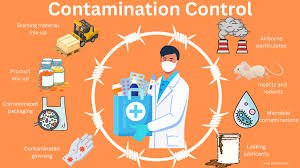Contamination Control Strategies for Manufacturing Area

Contamination Control Strategies for Manufacturing Area
In pharmaceutical manufacturing, contamination control is critical to ensure product quality, patient safety, and regulatory compliance. Contamination can occur in the form of particulate, microbial, chemical, or cross-contamination. A robust contamination control strategy involves preventive measures, continuous monitoring, and corrective actions.
Key Strategies
-
Facility & Equipment Design
-
Segregated cleanroom classifications (ISO/GMP standards).
-
Smooth, non-porous, and easy-to-clean surfaces.
-
Proper HVAC system with HEPA filtration and differential pressure.
-
Dedicated equipment or validated cleaning procedures.
-
Personnel Control
-
Strict gowning procedures (PPE, sterile garments, gloves, masks).
-
Controlled entry/exit with airlocks.
-
Regular training on aseptic practices and hygiene.
-
Restricted movement between different classified areas.
-
Environmental Monitoring
-
Routine monitoring of viable and non-viable particles.
-
Microbial monitoring of surfaces, air, and personnel.
-
Trending of data for early detection of risks.
-
Cleaning & Disinfection
-
Validated cleaning protocols for equipment and facilities.
-
Rotation of disinfectants to avoid microbial resistance.
-
Frequent sanitation of high-touch areas and critical surfaces.
-
Material & Product Flow
-
Segregated pathways for personnel and materials.
-
Use of pass-through hatches with interlocks.
-
Quarantine and controlled storage of raw materials.
-
Cross-Contamination Prevention
-
Dedicated manufacturing areas for high-potency drugs.
-
Use of closed systems and barrier technologies (RABS, isolators).
-
Proper line clearance and equipment cleaning verification.
-
Documentation & Control
-
SOPs for contamination control.
-
Deviations and CAPA management.
-
Data integrity in monitoring records.
-
Risk-Based Approach
-
Application of Quality Risk Management (QRM).
-
Implementation of Contamination Control Strategy (CCS) as per EU GMP Annex 1.
-
Continuous process verification and improvement.
✅ Summary: Contamination control in manufacturing areas requires an integrated approach involving facility design, personnel discipline, validated cleaning, environmental monitoring, and risk-based strategies to ensure consistent compliance and patient safety.
🎓 Discover one of the best Pharmaceutical Quality Assurance course available —click below to explore the course that’s shaping future Quality Assurance skills.
https://trcjw.on-app.in/app/oc/306166/trcjw

